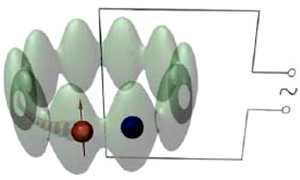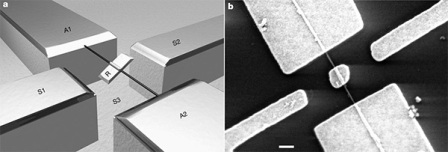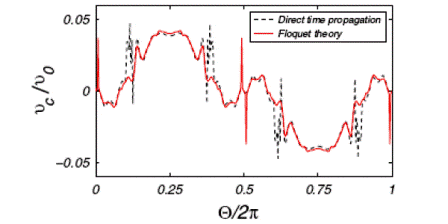Categories: Featured Articles » Interesting electrical news
Number of views: 13320
Comments on the article: 0
First nanoelectric motor
German theorists from the University of Augsburg have proposed an original model of an electric motor operating on the laws of quantum mechanics. A specially selected external alternating magnetic field is applied to two atoms placed in a ring-shaped optical lattice at a very low temperature. One of the atoms, which scientists called the “carrier”, begins to move along the optical lattice and after a while reaches constant speed, the second atom plays the role of a “starter” - due to the interaction with it, the “carrier” begins its movement. The whole structure is called a quantum atomic engine.
The first working electric motor was designed and demonstrated in 1827 by the Hungarian physicist Agnos Jedlic. The improvement of various technological processes leads to the miniaturization of various devices, including devices for converting electrical or magnetic energy into mechanical energy. Almost 200 years after the creation of the first electric motor, their sizes reached the micrometer threshold and stepped into the nanometer region.
One of the many micro / nanoscale electric motor projects was proposed and implemented by American scientists in 2003 in an article by Rotational actuators based on carbon nanotubes, published in Nature.

Fig. 1. Atomic quantum engine. Two different ultracold atoms (brown and blue balls) are in an annular optical lattice. See the text for details. Fig. from the article under discussion in Phys. Rev. Lett.

Fig. 2. Schematic drawing of a nanoelectric motor. a. The metal rotor plate (R) is mounted on a multi-walled carbon nanotube. Electrical contact to the rotor plane is through a carbon nanotube and anchors (A1, A2). Three stator electrodes (S1, S2, S3) located on a silicon oxide SiO2 substrate play the role of controlling elements of rotor rotation - they are supplied with electric voltage independently of each other. b. Image of an electric motor made using a scanning electron microscope. The length of the scale bar is 300 nm. Fig. from the article Rotational actuators based on carbon nanotubes in Nature
On a multi-walled carbon nanotube, there is a flat sheet of metal R, which plays the role of a rotor (Fig. 2). The nanotube is mounted on two electrically conductive anchors A1 and A2. The rotor is located between the three electrodes - the stators S1, S2 and S3. By applying a special voltage to the rotor and three stators, the direction and speed of rotation of the metal plate can be controlled. The multi-walled carbon nanotube in this design serves, firstly, as an electric jumper to supply current to the rotor, and secondly, as a mechanical fastening of the rotor.
And recently, theoretical physicists from Germany in an article by ac-Driven Atomic Quantum Motor, published in the journal Physical Review Letters, proposed a model of a micrometer-sized engine that operates on the laws of quantum mechanics. The engine consists of two interacting particles - two atoms located in an annular optical lattice and located at a very low temperature (Fig. 1). An optical lattice is a trap for such ultracold atoms (with temperatures on the order of milli or microkelvins) created by interfering laser beams.
The first atom is the “carrier” (brown ball in Fig. 1), the second atom is the “starter” (blue ball). Initially, the particles are not excited and are located at the bottom of the energy well of the lattice (at the level with the lowest possible energy value). An external time-varying magnetic field (control signal) is applied to the optical grating, which affects the “carrier” and does not affect the “starter”. The start of this engine, as a result of which the “carrier” begins its circular motion in the optical lattice, is carried out through interaction with another particle - the “starter”.
The presence of a “starter” atom in such a device is necessary for the full operation of the quantum engine.If there was no second particle, the carrier atom could not begin its directed motion along the optical lattice. That is, the task of the “starter” atom is to initiate the start of this engine, to give it a start. Actually, this is where the name of the second particle comes from. After some time, the “carrier”, already under the action of an alternating signal in the form of an external magnetic field, reaches its peak power — the atom’s speed reaches its maximum and remains constant in the future.
Now a few words about the conditions for the effective operation of such a quantum atomic engine. Theoretical research by German scientists showed that an external variable magnetic field should consist of two harmonic components with given amplitudes and with some phase shift between them. This phase shift between the components plays a key role in the engine - it allows you to control the engine, that is, change the speed and direction of movement of the "carrier". If a simple harmonic signal were used and the magnetic field changed in time, for example, according to the sine law, then the “carrier” could equally move in the optical lattice clockwise or counterclockwise, and it would be impossible to control the direction and speed of its motion. In fig. Figure 3 shows a graph representing the speed and direction of rotation of the “carrier” as a function of the phase difference of the two harmonics, calculated using different quantum-mechanical approaches.

Fig. 3. Dependence of the motion velocity of the carrier atom vc on the phase difference between the harmonics (components) and the control magnetic field, calculated by two different quantum-mechanical methods (red solid line and black dashed line). A negative speed value corresponds to a different direction of rotation. The speed of the carrier is measured in units of some characteristic speed v0. Fig. from the article under discussion in Phys. Rev. Lett.
It is seen that the maximum “carrier” velocity will be observed when the phase difference is π / 2 and 3π / 4. A negative value of speed means that the atom ("carrier") rotates in the opposite direction. In addition, it was possible to establish that the velocity of the “carrier” atom will reach its constant value only when the number of nodes of the optical lattice is greater than or equal to 16 (see Fig. 3, the number of nodes is, roughly speaking, the number of jumpers between "Hills"). So, in fig. 3, the dependence of the “carrier” velocity on the phase difference is calculated for 16 nodes of the optical lattice.
In order for the device described here to be called a full-fledged engine, it is still necessary to find out how it works under the influence of any load. In a conventional engine, the magnitude of the load can be described as the moment of any external forces or forces. An increase in load leads to a decrease in the speed of rotation of the engine, with a further increase in the moment of forces, the engine can begin to rotate in increasing direction with increasing speed. If you change the direction of application of the torque, then an increase in the load will lead to an increase in the engine speed. In any case, it is important that a smooth continuous increase in load gives the same smooth and continuous change in engine speed. We can say that the dependence of the rotation speed on the magnitude of the engine load is a continuous function.
The situation is completely different with a quantum atomic engine. Firstly, there are many forbidden values of the moment of external forces at which the quantum engine will not work - the speed of the “carrier” will be zero (unless, of course, the thermal motion of the atom is excluded). Secondly, with an increase in the permitted load values, the engine speed behaves in a nonmonotonic manner: an increase in the moment of forces leads first to an increase in the “carrier” speed, then to its decrease, and then to a change in the direction of rotation of the atom with a simultaneous increase in the speed of motion.Generally speaking, the dependence of the "carrier" speed on the magnitude of the load will be a discrete function that also has fractal properties. The fractality property means that the above-described behavior of a quantum atomic engine will be repeated in a regularly expanding range of load values.
The article also proposes a diagram of the practical implementation of this quantum atomic engine. To do this, you can use an uncharged “starter” atom and an ionized “carrier” atom (first option), or a “starter” can be a particle with zero spin, and a “carrier” can be an atom with a non-zero spin (second option). In the latter case, the authors propose using the ytterbium 174Yb isotopes with zero spin (i.e., the boson) and its 171Yb isotope with half-integer spin (fermion) or 87Rb, known as the material for the first Bose-Einstein condensation, and the 6Li fermion. For example, if a lithium atom is used as a “carrier”, then the optical lattice constant for some other additional engine parameters (in particular, the depth of the energy well of the optical lattice and the mass of atoms) should be 10 μm, and the frequency of the control field is less than 2 Hz. In this case, the quantum atomic engine will reach the “peak of power” (the speed of the “carrier” becomes constant) in 1 minute. With a decrease in the period of the optical grating, the device reaches its maximum power after 10 seconds.
Experimenters have already managed to respond to a published article by German theorists. They believe that putting two separately taken atoms into such an annular optical array is technically, maybe, real, but very difficult. In addition, it is unclear how to extract useful work from such an engine. So it is not known whether the project of such a quantum atomic engine will be implemented or whether it will remain a beautiful model on paper by theoreticians.
Source: A. V. Ponomarev, S. Denisov, P. Hänggi. Ac-Driven Atomic Quantum Motor // Phys. Rev. Lett. 102, 230601 (2009).
See also: Minato Magnetic Motor
See also at bgv.electricianexp.com
:
